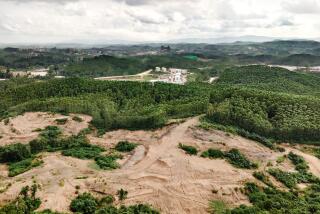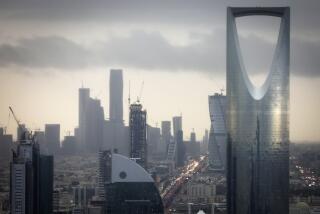Sri Lanka confronts ex-leader’s extravagant projects in ‘middle of nowhere’
Reporting from Hambantota, Sri Lanka — This remote coastal scrubland, a haven for wild elephants and migratory birds that is several hours away from the nearest city, seems like an odd place to attempt to create a major commercial hub.
Yet such was the whim of former President Mahinda Rajapaksa, a local son who, thanks to Chinese loans, poured immense sums into pet projects during the decade he held this island nation in his grip.
Since he was voted out of office in January, Rajapaksa’s extravagant spending in his home district, much of it named for himself, looks ever more like monuments to folly.
A giant Indian Ocean harbor being blasted out of the island’s southern shoreline has seen costs soar well past $1 billion, and officials say it is unlikely to break even for years. A $210-million international airport built two years ago has hundreds of employees but receives just a handful of passengers a day.
The 35,000-seat Mahinda Rajapaksa International Cricket Stadium and a new convention center are rarely used, as are miles of expansive new highways that see little traffic apart from the occasional herd of cattle.
“It’s a crying shame how much money was spent,” said Harsha de Silva, deputy minister for policy planning and economic affairs in Sri Lanka’s new government. “Why is an airport in the middle of nowhere? Why are you building a road to the middle of nowhere?”
It’s not as if Sri Lankans didn’t ask those questions before, but under Rajapaksa’s increasingly despotic administration, dissent was ignored or punished. After his narrow and surprising election defeat, the country of 20 million is waking up to the excesses of his rule with what appears to be a collective hangover.
SriLankan Airlines, the deeply indebted national carrier, announced that it would cease operating from Mattala Rajapaksa International Airport in the town of Mattala, north of Hambantota. The twice-daily flights were losing the airline $8 million a year, company officials said.
New President Maithripala Sirisena has ordered a review of all of Rajapaksa’s projects – and it is a long list. To cement the government’s victory in a 26-year civil war against northern Tamil rebels, Rajapaksa embarked on a $6-billion spending binge on infrastructure projects starting in 2009.
More than two-thirds of the projects, including the port and airport at Hambantota, were financed by Chinese banks at interest rates as high as 6.3% annually, several times what other lenders offered, and did not go through open bidding processes, officials say. Authorities are investigating whether contracts were padded to benefit members of Rajapaksa’s government, which included more than two dozen members of his extended family. No charges have been filed.
In the meantime, finance officials are exploring ways to restructure the Chinese loans. Government lawyers are poring over contracts, trying to scale back some projects that haven’t yet begun, such as a 500-acre development on reclaimed land in the capital, Colombo, where the ex-president envisioned luxury high-rises and a Formula One racetrack.
To Rajapaksa, the projects were powerful symbols of Sri Lanka’s expansion from a small, war-ravaged economy to one of the fastest growing in South Asia.
He and members of his family did not respond to requests for comment. In an interview this month with the South China Morning Post, he defended his actions.
“I wanted development for Sri Lanka and China was the only one which had the resources and the inclination to help me,” Rajapaksa said.
Opponents counter that he built by fiat, bypassing environmental studies and economic assessments, and that China, seeking to boost its influence on the doorstep of rival India, took advantage of his haste.
“They were vanity projects for Rajapaksa, plain and simple, and China was quite happy to nurture his vanity,” said Paikiasothy Saravanamuttu, executive director of the Center for Policy Alternatives, a think tank in Colombo.
Business leaders in Hambantota said they were never consulted about the giant structures that began proliferating in their district like mushrooms after a monsoon.
A predominantly fishing and farming area that is still recovering from damage sustained in the 2004 Indian Ocean tsunami, Hambantota historically has been one of the poorer pockets of the country.
Airplane tickets and use of the convention center, as well as a five-star hotel planned for the port complex, are out of the financial reach of most residents, raising questions about their long-term viability.
Local leaders say the terms of the Chinese loans required Sri Lanka to hire mainly Chinese construction companies, who brought in their own workers, leaving few contract jobs for residents.
“All the projects generated some temporary employment, but it was not up to the expectations of the people,” said Azmi Thassim, founding president of the Hambantota District Chamber of Commerce. “There has been very minimum impact for the area.”
Rajapaksa inaugurated the country’s second international airport with fanfare in March 2013, with state media proclaiming it “an initiative that changed the face of global aviation.” By mid-2014, however, its financial state was already precarious: Under questioning from opposition lawmakers, aviation officials reported that the airport’s total revenue in one month was 16,000 rupees, or about $120.
With SriLankan Airlines having pulled out, only one commercial airline operates at Rajapaksa International: low-cost carrier flydubai, which arrives every morning via Colombo, disgorging a few European tourists bound for the island’s southern beaches. An hour later, it returns to Dubai.
For the rest of the day, the fountains and air-conditioning are switched off to save costs and the airy, modern passenger terminal is vacant except for some of the 500-odd employees who remain on the payroll. On a recent afternoon, a few young staff members in white shirts and lanyards ate lunch sitting in plush red chairs while a uniformed man gamely staffed the information kiosk, his voice echoing through the hall when a rare visitor approached.
“Yesterday we had 25 people arrive,” the man said brightly. “Usually it is only five or 10.”
The 3-square-mile site has upended the local ecosystem. Wild elephants often roam up to the airport perimeter, which is ringed by an electric fence. Peacocks have occasionally flown into the runway area and collided with moving aircraft.
“It was not the most logical place for an airport,” said Prithiviraj Fernando, chairman of the Center for Conservation and Research, an independent environmental group.
Aviation officials are reportedly considering marketing the airport as a transshipment hub for global couriers such as FedEx and UPS, or converting it into a flight school.
Officials seem more optimistic about the Magampura Mahinda Rajapaksa Port, which was carved out of bedrock on a 4,000-acre site next to Hambantota town. Sri Lanka has long sought a second port to alleviate congestion in Colombo and take advantage of its position near shipping lanes connecting Southeast Asia with Africa and the Middle East.
But experts say Hambantota harbor requires near-constant dredging, possibly interfering with sea life. The better choice, they say, would have been a site on the eastern edge of the island, Trincomalee, one of the best natural deepwater harbors in the Indian Ocean.
According to a report in the Sunday Leader newspaper, a study showing the challenges at the Hambantota site was submitted to Rajapaksa in the early 2000s, when he was minister of ports and fisheries.
“He didn’t care,” Saravanamuttu said. “He thought that if he ruled long enough, from here to eternity, he could move the capital down there.”
Twitter: @SBengali
More to Read
Sign up for Essential California
The most important California stories and recommendations in your inbox every morning.
You may occasionally receive promotional content from the Los Angeles Times.











